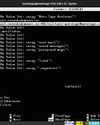AMD Ryzen 5 - 2400G
Linux Format
|May 2018
Finally, next-gen integrated graphics performance arrives inside a CPU worthy of your main desktop system. Jarred Walton is suitably impressed.


After the tour de force of the Ryzen processor rollout over 2017, many had high hopes for the future Ryzen APUs (that’s with integrated graphics) and finally AMD has released its first models. The eternal problem with integrated graphics is trying to combine a good CPU with a decent GPU while keeping price, power, and other aspects in check. This is the best APU AMD has ever released, and it effectively kills off the Ryzen 5 1500X and lower CPUs.
On the CPU side of things, the first batch of Ryzen processors all used the same dual CCX (CPU Complex) design, with Threadripper going so far as to include two of those chips on a single package. The Ryzen CCX consists of four CPU cores, each with 512K of L2 cache, and a shared 8MB L3 cache. On the previous quad-core implementations (Ryzen 3 1200/1300X and Ryzen 5 1400/1500X), each CCX ends up with two disabled cores, and depending on the product, half of the L3 cache may also be disabled. For the Ryzen APUs, there’s only a single CCX, and a maximum of 4MB of L3 cache. That simplifies some aspects of multi-core operation – there are no cross-CCX latencies to worry about – but the reduced L3 cache size may at times be a factor.
In place of the second CCX, AMD has included a nice little graphics solution. The Ryzen 5 2400G calls it Vega 11, which is a Vega core with 11 enabled CUs (Compute Units), each of which includes 64 streaming processors (aka GPU cores). Eleven seems like an odd number, so there might be another CU disabled, but AMD didn’t comment on this.
Diese Geschichte stammt aus der May 2018-Ausgabe von Linux Format.
Abonnieren Sie Magzter GOLD, um auf Tausende kuratierter Premium-Geschichten und über 9.000 Zeitschriften und Zeitungen zuzugreifen.
Sie sind bereits Abonnent? Anmelden
WEITERE GESCHICHTEN VON Linux Format

Linux Format
Create your first WebSocket service
Mihalis Tsoukalos explains how to use the Go programming language to work with the WebSocket protocol.
9 mins
April 2023

Linux Format
Fantastic Mr Firefox
Nick Peers takes a trip down memory lane to reveal the story behind the rise - and slight fall - of Mozilla's popular web browser.
9 mins
April 2023

Linux Format
Set up your terminal and email like it's 1983
Jump in the hot terminal time machine with Mats Tage Axelsson who emails from the command line using the latest technology.
8 mins
April 2023

Linux Format
Universal layer text effects with GIMP
Posters use them, films and presentations are hard to imagine without them: text effects. Attract attention with Karsten Günther and GIMP.
8 mins
April 2023

Linux Format
Jump to a federated social network
Nick Peers reveals how you can get up and running with this free, decentralised and non-profit alternative to Twitter.
9 mins
April 2023

Linux Format
Free our SOFTWARE!
Taking anything for granted is dangerous, so Jonni Bidwell and Mike Saunders revisit how the free software movement got started to help free us from proprietary tyranny!
4 mins
April 2023

Linux Format
Master RPI.GPIO
Les Pounder goes back to the early days of the Raspberry Pi - and his career with this classic library! -
5 mins
April 2023

Linux Format
Waveshare Zero to Pi3
Transform your Pi Zero into a Pi 3, they promised Les Pounder, but it's more like adding on go-faster stripes.
2 mins
April 2023

Linux Format
The Best OPEN SOURCE Software Ever!
In an attempt to trigger controversy, Michael Reed and Neil Mohr unequivocally state these are the greatest free software apps ever. Probably. We’re just trying to be helpful.
19 mins
April 2023

Linux Format
Linux-Mandrake 7
Simplicity and a wide range of applications make this a great distribution for all Linux users.
2 mins
April 2023
Translate
Change font size

